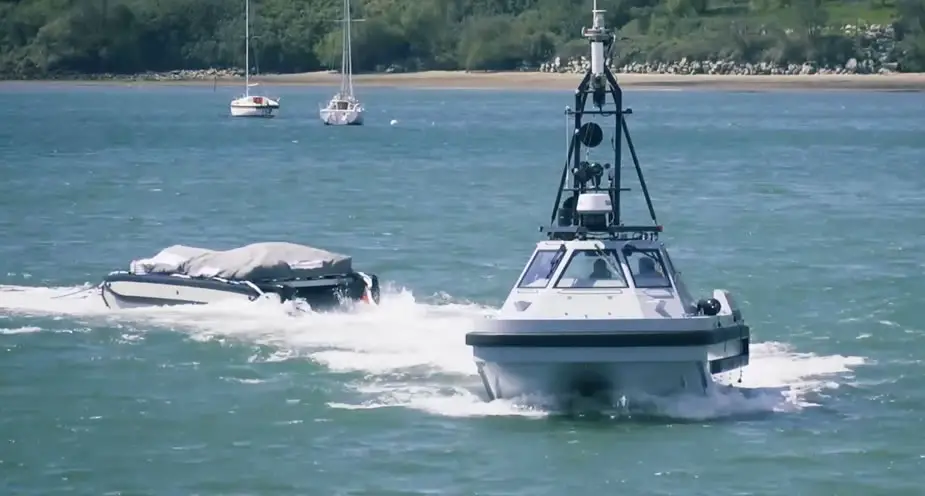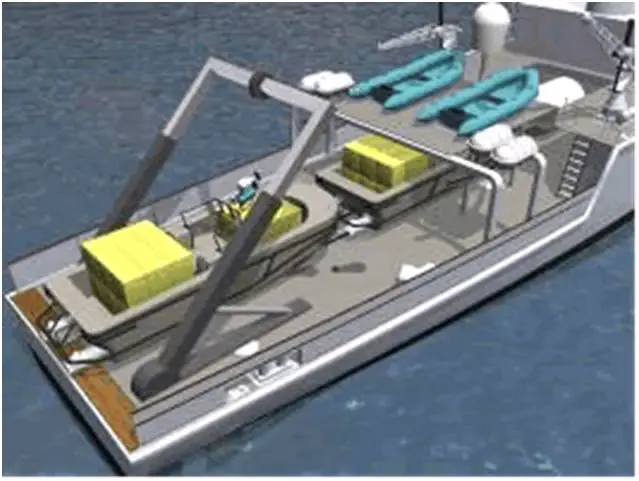Breaking news
First ARCIMS Unmanned Minesweeping System Handed Over to Royal Navy.
An autonomous minesweeper system that can safely clear sea lanes of mines has been handed over to the Royal Navy. Following a period of successful trials the demonstrator system could go on to be used by the Royal Navy in the future to defeat the threat of modern digital mines.
 An ARCIMS autonomous minesweeper system that can safely clear sea lanes of mines has been handed over to the Royal Navy, Defence Minister Guto Bebb has announced. Crown copyright.
An ARCIMS autonomous minesweeper system that can safely clear sea lanes of mines has been handed over to the Royal Navy, Defence Minister Guto Bebb has announced. Crown copyright.
The system has been designed and manufactured by Atlas Elektronik UK in Dorset, under a £13 million contract with the Ministry of Defence which has sustained around 20 jobs and created 15 new jobs with the company.
Defence Minister Guto Bebb said:
This autonomous minesweeper takes us a step closer to taking our crews out of danger and allowing us to safely clear sea lanes of explosives, whether that’s supporting trade in global waters and around the British coastline, or protecting our ships and shores. Easily transported by road, sea and air, the high-tech design means a small team could put the system to use within hours of it arriving in theatre. We are investing millions in innovative technology now, to support our military of the future.
The system’s innovative and modernised technology has the ability to defeat today’s digital sea mines which can detect and target military ships passing overhead. The sweeper system, which features a “sense and avoid” capability, could also work together with other similar autonomous systems for the common goal of making our waters safer.
The project also aims to demonstrate the viability of an unmanned system that can safely and successfully clear mines and which is designed to be operated from a land or ship-based control station and can be deployed from a suitable ship or port.
Over the last four months, the system has been put through its paces by Atlas Elektronik and Defence Equipment and Support team members and the Royal Navy’s Maritime Autonomous Systems Trials Team (MASTT).
 Crown copyright infographics.
Crown copyright infographics.
The system was tested against a number of performance requirements, for example, how well it cleared mines, whether the autonomous system could successfully avoid obstacles and the overall system performance.
Brigadier Jim Morris Royal Marines - Assistant Chief of the Naval Staff in Maritime Capability, and Senior Responsible Officer for the Mine Counter Measures and Hydrographic Capability (MHC) programme said:
The Mine Countermeasures and Hydrographic Capability Combined Influence Minesweeping system is the Royal Navy’s first fully autonomous capability demonstrator and paves the way for the introduction of this technology across the full range of maritime capabilities.
Combined Influence Minesweeping is a critical component of the Mine Countermeasures capability. This autonomous system will restore the Royal Navy’s sweep capability, enabling it to tackle modern digital mines that may not otherwise be discovered in challenging minehunting conditions.
This autonomous sweep system represents a fundamental step in the Navy’s transition to autonomous offboard systems to counter the threat posed to international shipping by the sea mine; we look forward to commencing demonstration of the associated minehunting system in 2019.
The handover of the system to the Royal Navy is a significant milestone for the Mine Countermeasures and Hydrographic Capability (MHC) programme, which aims to de-risk maritime autonomous systems and introduce these new technologies into the Royal Navy.
Director Ships Support Neal Lawson, of the MOD’s procurement organisation, Defence Equipment and Support, said:
The autonomous minesweeper offers a commander the ability to defeat mines that cannot be countered by current hunting techniques and significantly reduces the risk to crew members in pressured and time-constrained operations.
The system can offer greater flexibility and upgradability, allowing the Royal Navy to respond better to the sea-mine threat in the long-term and operate more effectively around the world and I’m therefore delighted to be back here at Bincleaves, where I started my MOD career 29 years ago, to mark the handover of this critical programme.
 Hunt-class MCM vessels of the Royal Navy are set to be modified in order to act as mothership for the USV system: They will be able to carry two USVs in tandem with an A-frame for deployment and recovery.
Hunt-class MCM vessels of the Royal Navy are set to be modified in order to act as mothership for the USV system: They will be able to carry two USVs in tandem with an A-frame for deployment and recovery.
The system will now undergo a series of more detailed trials with the Royal Navy.
The Royal Navy has a proud history of minesweeping, dating from World War One when even the likes of fishing trawlers were converted for use, dragging a chain from the vessel to clear German mines. Today, with far more sophisticated equipment, the service is still called upon to clear the waters of ordnance and maintains a world-leading role in minehunting, training alongside allies in the Mediterranean and the Gulf.
The MOD has committed 1.2% of the £36bn defence budget, supported by a dedicated £800m Innovation Fund, to cutting-edge science and technology.


























